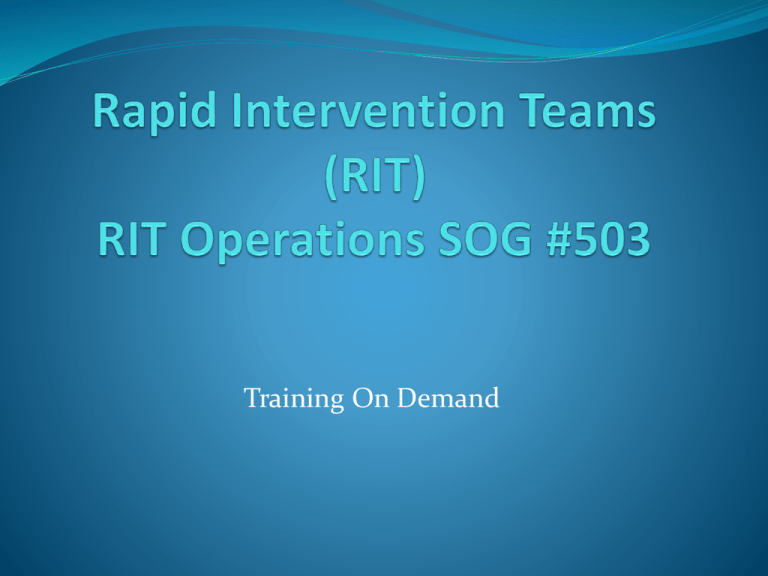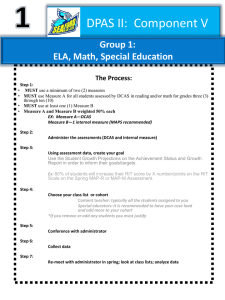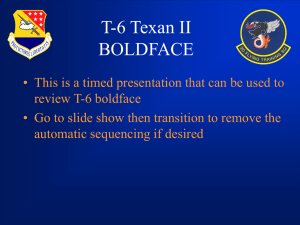Rapid Intervention Teams (RIT)
advertisement

Training On Demand Purpose To provide fire fighters at an emergency incident a team with pre-assigned duties aimed at rescuing downed, lost or trapped firefighters. A Rapid Intervention Team (RIT) should be established when significant risk is present to firefighters or when Incident Command (IC) deems necessary. RIT Structure The RIT should consist of 4 members. The minimum number of members assigned to RIT shall be 2. The crew should be completely fresh and standing by in a location that would allow quick access to the hazard area. RIT should always have the designation of RIT Group. The IC may assign RIT I, RIT 2, or RIT 3 groups when necessary. RIT Pack/ Location All apparatus carrying a RIT pack shall have a reflective sticker mounted on the exterior of the compartment door indicating its location on the rig. The RIT pack should be clearly marked with the letters RIT. A RIT pack is a Self-Contained Breathing Apparatus (SCBA) or air equipment specifically meant to provide emergency air supply to trapped firefighters. RIT Assignment Upon arrival or assignment as the RIT, members will report directly to the IC. The RIT will remain in contact visually or verbally (by radio is acceptable) with the IC at all times during the incident. Should the IC require the use of the RIT for a tactical assignment, a new RIT should be formed immediately. RIT Equipment The rapid intervention team members will have the following equipment. If possible, this equipment should be laid out on a labeled tarp and be dedicated for the RIT only. Full protective gear including SCBA donned with the cylinder valve turned on. When available, the entire RIT should utilize 1 hour cylinders. Portable radios with all members monitoring the tactical channel to listen for a MAYDAY or pertinent information which may affect firefighter safety. Flashlights RIT pack or if none is available an extra SCBA and bottle for the victim. Consideration will be made when firefighters from other departments are on scene to assure there are compatible RIT packs or SCBA available. Forcible entry tools. Rope bag. Thermal imager and spare battery. Any additional equipment that may be needed based on the type of incident or occupancy (i.e.: hose line with separate water supply, saws, extrication equipment, backboard, etc.) RIT Preparations Once the RIT gathers its equipment, the members will conduct a size-up of the structure or incident. The size-up includes A walk-around of the structure to locate any potential problems S u r v e y and to open accesses or provide egress where necessary. RIT Group will then stage in an area near the hazard zone that affords the best access to the majority of the members who may need assistance. Size-up of the structure and the monitoring of fire conditions should be on going. This can include periodic 360's of the structure. RIT Deployment If anyone suspects a firefighter may be missing, they should immediately notify IC. An absent member of any crew will automatically be assumed lost or trapped in the hazard zone until otherwise determined safe. A member or crew that is lost, trapped, disoriented or facing imminent danger, injury or death shall call on the radio "MAYDAY, MAYDAY, MAYDAY". Radio traffic should then be limited to the IC and the member calling MAYDAY. After necessary communications with IC, the member calling MAYDAY should activate their PASS device. RIT Deployment Division/Group/Company Officers will be asked for a Personnel Accountability Report (PAR) and/or receive task assignments. The use of a PAR may not be adequate to account for all personnel and the IC may need to recall all personnel out of the hazard area to get an adequate roll call. The accountability system should be helpful in determining the number of missing fire fighters and their last known location. The IC needs to find out: 1. 2. 3. 4. 5. 6. Who is missing. The missing firefighter's last known location. Who was working with the firefighter. Was there an explosion or collapse. What is the state of the firefighter's air supply. What are the fire/smoke and heat conditions in the structure RIT Deployment cont. RIT will report to IC and a Rescue Action Plan developed. A Safety Officer shall be assigned to RIT and a second Safety Officer assigned to the remainder of the fire ground incident. RIT will be deployed at the best-determined location. All other fire ground operations should be assigned another radio frequency and IC should delegate an operation chief to conduct all other fire ground operations. Additional resources (mutual aid) may be needed. Ventilation and lighting may be priorities in the rescue zone. The hospital should be put on standby. A helicopter service may be needed. Medic units should be standing by and ready for any victims. Division/Group/Company Officers need to maintain good control of personnel in their assigned areas. All firefighters may want to help with the rescue, but continuing to fight the fire or performing other tasks may be just as important to the rescue effort.











